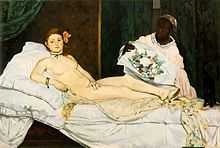The Fifer
.jpg) | |
| Artist | Édouard Manet |
|---|---|
| Year | 1866 |
| Type | oil painting |
| Dimensions | 160 cm × 97 cm (63 in × 38 in) |
| Location | Musée d'Orsay, Paris |
The Fifer or Young Flautist is a painting by French painter Édouard Manet, made in 1866. It is currently kept in the Musée d'Orsay, Paris.
History
Manet painted The Fifer after a trip in Spain that he made in 1865, where he discovered the work of Diego Velázquez. The painting, in which Manet reflected the influence of Spanish painting, was rejected by the jury of the Paris Salon in 1866. The painting was exhibited in 1867. In 1884, it was present at the major retrospective exhibition of his work organized as a tribute, after Manet's death in 1883.
The rejection by the Salon jury prompted the writer Émile Zola to publish a series of articles in defense of Manet in the newspaper L'Événement.[1]
Between 1873 and 1893, the painting was held by Jean-Baptiste Faure, French composer and baritone, friend of Manet. In 1893, it returned to the collection of Durand-Ruel, and was acquired the next year by Count Isaac de Camondo, remaining in his collection until 1911, then was delivered to the French state as a donation. The painting was intended for the Musée du Louvre, where it was not exhibited to the general public until 1914. In 1947, it was moving to the Galerie nationale du Jeu de Paume, a showroom located in the Jardin des Tuileries and belonging to the Louvre. It remained there until 1986, when it was brought to the Musée d'Orsay, like the rest of the collection of Impressionist paintings in the Louvre. It can currently be seen in room 14 of level 0 of the Musée d'Orsay.[2]
Analysis
As in the painting by Spanish painter, Manet conceived a shallow depth, where vertical and horizontal planes are barely distinguishable.[3] According to Peter H. Feist, in The Player fife, Manet showed the attraction for "the decorative effect of a large single figures, with emphatic contours and placed before a background surface."[4] Facing the monochrome background, strongly colored highlights the figure based on but a reduced palette of colors, dominated the impasto technique: the very sharp black of the jacket and shoes, red pants, white strap, etc.. As a result, the figure stands "firm, smooth and alive."[1][3]
Moreover, as in Velázquez's work, Manet also portrayed an anonymous character, a teenage musician of the band of the Imperial Guard, who was sent to Manet by commander Lejosne,[5] "treated like a grandee of Spain."[3] Additional models may have also posed for the figure: the likenesses of both Léon Leenhoff and Victorine Meurent have been seen in the boy's face and figure.[6]
This painting was an object of interest in the television show Hogan's Heroes episode "Art for Hogan's Sake".
References
- ↑ 1.0 1.1 VV.AA. (2005). Historia del arte: El realismo. El impresionismo (in Spanish). Salvat / El País. pp. 135–36. ISBN 84-471-0336-6.
- ↑ "Notice de l'œuvre" (in French). Musée d'Orsay. Retrieved 3 January 2010.
- ↑ 3.0 3.1 3.2 "El pífano" (in Spanish). Musée d'Orsay. Retrieved 3 January 2010.
- ↑ Feist, Peter H. (2006). "En camino hacia la propia posición". El impresionismo (in Spanish) (Walther, Ingo H. ed.). Colonia: Taschen. p. 76. ISBN 978-3-8228-5052-7.
- ↑ VV.AA. (2005). Historia del arte: El realismo. El impresionismo (in Spanish). Salvat / El País. p. 126. ISBN 84-471-0336-6.
- ↑ Armstrong, Carol. Manet's Le Déjeuner sur l'hérbe. Cambridge University press, 1998, pp. 98-100. ISBN 0-521-47466-3
| ||||||||||||
